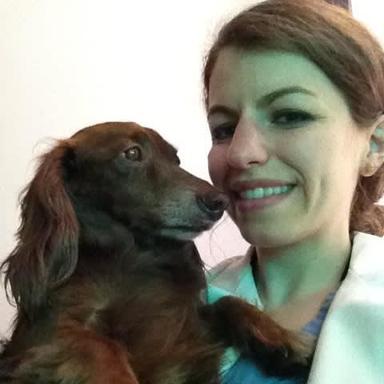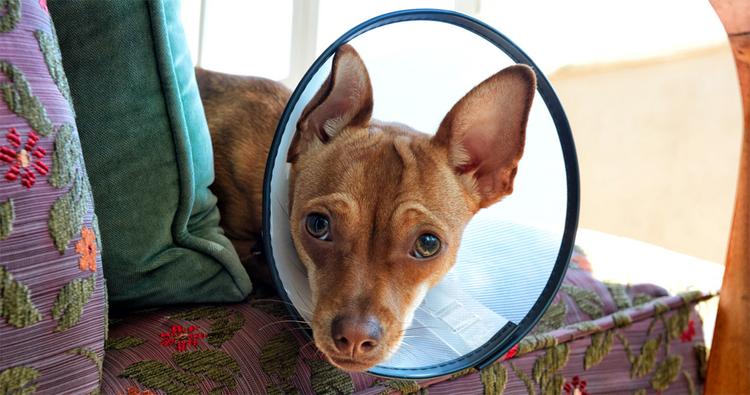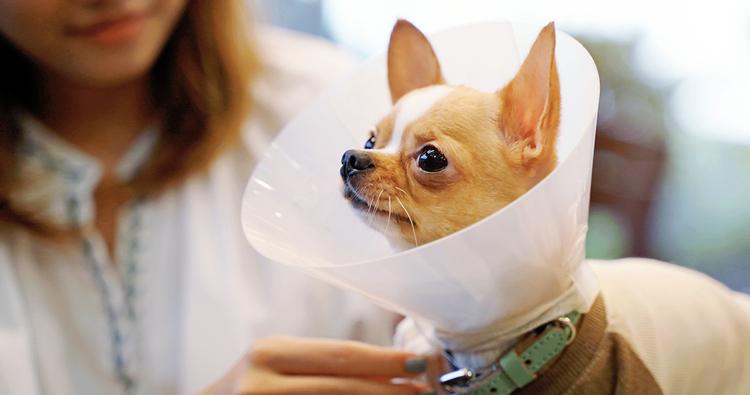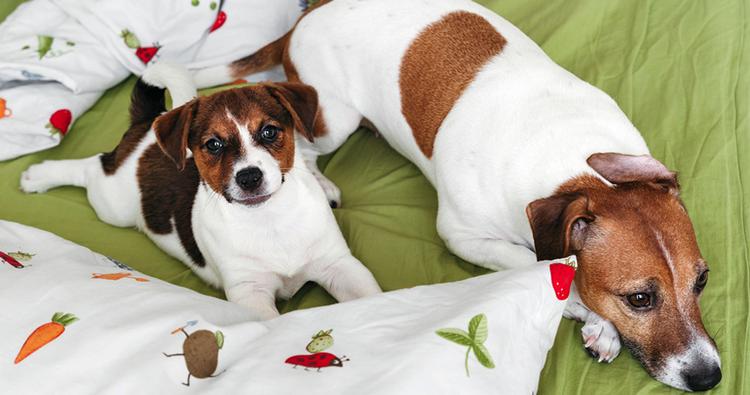by Dr. Amy Fox, DVM, | May 17, 2023

Peter Meciar / Stocksy
If you are considering fostering a pregnant dog, or a pregnant stray dog happens to find you, it’s important to know some key information about dog pregnancy and birth to help you care for a mama dog and her puppies. Get ready for lots of hard work, a whole lot of messes, and the most adorable, rewarding experience you may ever have!
In this article:
How Long Are Dogs Pregnant?
Dog pregnancies last about 65 days from the time of ovulation to birth. In most cases, we do not know the timing of a dog’s ovulation or even the exact date of conception, so it can be difficult to estimate an exact due date; most pregnancies are estimated to last about 58-68 days in total. A veterinarian may be able to give a general timeline for when the puppies will be born.
Dog Pregnancy Week by Week
Weeks one to three: Fertilized eggs begin to divide within the uterine tube. Embryos enter the uterus by day 11, and implantation occurs between days 16 and 18.
Week four: Head, eyes, and vertebrae form along with internal organs.
Weeks five to six: External features like skin color, nails, and whiskers are forming along with sex organs. The fetus experiences the most growth between days 40 to birth.
Weeks seven to eight: The skeleton is fully formed and may be visible on x-rays around day 45.
Week nine: Fetus is fully formed and preparing for birth. Most puppies can be safely delivered after day 57. Their eyes are sealed at birth, and they cannot hear.
How To Tell If Your Dog Is Pregnant
A pregnant dog will show physical and behavioral changes. Some of the most common signs early in pregnancy are enlarged mammary glands and nipples, changes in the color of the nipples, clear vaginal discharge, and/or changes in appetite (either decreased or increased). Later in the pregnancy, additional changes such as weight gain, enlargement of the belly, swelling of the vulva, and milk production may occur. Pregnant dogs may also act more clingy and start showing signs of nesting behavior, such as collecting blankets, towels, and/or toys to create a nest-like space for their future puppies.
At Home
If you are suspicious that your dog may be pregnant due to signs such as swelling of the mammary glands and vulva, weight gain, and/or changes in behavior, it’s best to consult a veterinarian. Many other conditions can have signs similar to pregnancy, so it’s best to see your vet to make sure. However, if you have a pup that is easy to handle and allows you to, you can gently press on her mammary glands to see if milk comes out, which would indicate she is lactating and likely pregnant.
Dog Pregnancy Symptoms to Watch For
Enlarged mammary glands and nipples
Nipples that change color to a darker or pinker shade
Swollen vulva
Clear vaginal discharge
Changes in appetite (increased or decreased)
Weight gain
Growing belly
Milk production
Clingy behavior
Nesting behavior
At The Vet
Vets use a number of tools to diagnose a pregnancy and learn about the fetuses. The first step is usually abdominal palpation, or gently applying pressure on the belly to try and feel if the uterus is enlarged and/or if they can feel any fetuses. This technique doesn’t require special equipment, but has some drawbacks: Other structures in the belly, including poop, may feel similar to a uterus early in pregnancy, making it hard to accurately determine if a dog is pregnant. A dog with a very large belly, or one who is nervous or tense, will also be difficult to palpate.
Many vets may then use a form of imaging, such as an x-ray or ultrasound, to get more visual clues. X-rays, or radiographs, can show if the uterus is enlarged. The fetuses will only be clearly visible on an x-ray once their bones mineralize, which happens around day 45, but once they are, a vet can try to count how many fetuses are present.
Using an ultrasound has additional advantages as it allows a vet to look for heartbeats in the fetuses, which may be present as early as day 25, and to observe earlier changes in the uterus which may be consistent with pregnancy.
Finally, a hormone test can be performed on a urine or blood sample to test for the presence of Relaxin, a hormone secreted by the placenta. This test tends to be most accurate after 20 days of pregnancy.
None of these techniques are 100 percent accurate, especially for counting the number of fetuses, so there may be some surprises to come after birth.
False Pregnancy in Dogs
Some dogs who appear pregnant are actually experiencing false pregnancies. As the name suggests, a false pregnancy mimics many signs of pregnancy — including enlarged mammary glands, milk production, and nesting behaviors — except the dog is not pregnant. This can occur due to hormonal changes, and most cases resolve on their own, but there are some treatments that can help. Any complications resulting from a false pregnancy, such as mastitis, or infections of the mammary glands, must also be treated.
How to Care For a Pregnant Rescue Dog
A pregnant rescue dog is more likely to have underlying medical problems that may make pregnancy more difficult, so make sure to see a vet. All pregnant dogs, however, need to eat a special diet that supplies extra calories and nutrients during pregnancy and nursing. Make sure the food your pregnant dog eats is labeled for “growth and development,” or “pregnancy and lactation,” and/or that it says it is appropriate for “all life stages” to ensure it can meet these needs. Pregnant dogs need to eat more frequently as well.
Other important considerations during pregnancy include modifying exercise as your pup’s belly grows, minimizing stress, avoiding situations where your dog may get sick from other dogs, and preparing for the arrival of the puppies.
Vet Visits
Rescue pups who were strays or previously not properly cared for may have additional medical problems that need to be addressed to ensure they are strong and healthy for pregnancy. It is especially important to see a vet as soon as you suspect a rescue dog is pregnant so they can be treated for common conditions such as intestinal parasites, fleas, ticks, skin problems, or infections. However, some treatments, medications, and vaccinations are not safe to give to a pregnant dog, so it is important to consult with a vet before giving any treatments, including over-the-counter products.
Exercise
Pregnant dogs will gain weight during their pregnancy, but they must avoid excess weight gain because excess fat can cause problems in delivery, such as interfering with uterine contractions and the dog’s ability to push out the fetuses. Ideally, dogs should gain no more than 25 to 30 percent of their pre-pregnancy weight and continue to exercise during pregnancy.
The best exercise for pregnant pups is walking, as the speed and length of walks can be adjusted to accommodate the pup’s growing belly. In most cases, walking at a pace that seems comfortable for the dog, without her becoming too winded or tired, is a good approach. If she seems to get tired or just wants to lie down during the walk, head home and let her rest. In the final weeks of pregnancy, she may only be able to go out for short walks to pee and poop, which is fine. Always consult a vet regarding what is safe and appropriate for your particular pregnant dog.
Nutrition
Proper nutrition can prevent a lot of complications in pregnancy and nursing. Pregnant dogs need to eat food that is labeled as appropriate for “growth and development,” “pregnancy and lactation,” and/or “all life stages.” These foods contain enough calories and important nutrients like calcium to meet pregnant dogs’ needs.
Pregnant dogs gain the bulk of their weight after day 40 of pregnancy and will need even more food in those last three to four weeks of pregnancy. They should eat small, frequent meals, as their digestive tract gets squished by their growing uterus, and they will feel full quickly — but still need plenty of calories. It may be helpful to leave some dry food out all the time if you can’t provide frequent feedings throughout the day.
Pregnant rescue pups may need additional nutritional support as underlying medical problems such as intestinal parasites and/or a history of malnutrition and/or starvation may interfere with their absorption of nutrients and ability to gain weight. For this reason, it is extra important that rescue pups are under a vet’s care during their pregnancy.
Love
Like all rescue pups with a history of trauma and/or poor socialization, pregnant rescue dogs may need time to adjust to their new home and surroundings. Be sure to provide her time and space to decompress and settle in. While getting those vet visits taken care of is extremely important, it is worth remembering to take things slow and use lots of positive reinforcement to let her know she is safe and can trust her new humans too. This includes lots of praise, treats, toys, and/or cuddling if and when she is receptive to that. The more trust you build during the pregnancy, the better she will tolerate your presence once the puppies arrive.

Jovana Rikalo / Stocksy
Getting Ready for Puppies
As soon as you realize your new pup is pregnant, it is a good idea to start preparing for her to give birth by gathering the supplies you will need. Once the puppies are born, you will have a full house, so having everything ready ahead of time will make your life much easier. Early preparation is especially important with rescue dogs since their dates of conception and due dates are estimates; it is possible the puppies could arrive well before you were expecting them. Most times, mama dogs do nearly all the work of caring for their newborn pups, but sometimes they might need your help, so here are some tips to get you started.
Be Prepared
The arrival of the puppies can be both thrilling and stressful. If you have never seen a dog give birth, it is important to familiarize yourself with what is normal and what is cause for concern. Because rescue pups almost always have unknown due dates, make sure to have everything set up well before you think you will need it. Provide your pup with a quiet, private place where she can give birth and start to care for her newborn puppies. This should include a whelping box, which is a large box or pen with low sides so she can easily step in and out but will contain the puppies. Make sure to provide lots of clean bedding and layer that with disposable pee pads that you can easily change out to remove any fluids from labor and delivery, as well as pee and poop from the puppies. Other supplies to have on hand include:
Bedding
Disposable pee pads
Whelping box
Puppy formula, such as Esbilac
Heat source, such as heat lamp or heating pad
Puppy bottles and/or syringes with nipples
Disposable gloves
Cotton balls
Baby scale or gram scale
Signs of Labor in Dogs
The first stage of labor occurs when contractions start, and signs include restlessness and panting. The mama dog may act reserved and retreat to the privacy of her nesting area. This stage can last up to 12 hours, and it is very important to minimize handling and stress, which can sometimes prolong this stage or even stop labor, and to give her privacy during this time.
The next stage of labor begins with the birth of the first puppy. Normally another puppy is delivered every 60 minutes or less until they are all delivered. It is helpful to have an estimate of how many puppies are expected so you know if she has delivered them all.
Signs of problems during labor can include actively straining to push for more than 30 minutes without a puppy being delivered, more than four hours between births, or a puppy that is visibly stuck in the birth canal. Consult your vet or an emergency clinic right away if you notice any of these signs.
After the Puppies Have Arrived
In most cases, the mama dog knows how to care for her newborn pups, and the best thing to do is give her space to care for them. Always make sure she has access to food and water and that the bedding is clean in the whelping box. Make sure she has a quiet and private space to nurse them without other pets around and that everyone in the household knows to give her privacy.
Some new moms are very stressed by their babies being touched or handled, so it is best to give the mama dog time to settle in with her babies without any interference. If you need to handle the puppies, be sure to wash your hands thoroughly beforehand and try to keep the puppy with mom so she can see what you are doing to minimize her stress. Keep in mind that newborn puppies are highly susceptible to infections, and it will be many weeks before they can get their vaccines, so always wash your hands before handling them and keep their space clean.
If mom tolerates it, it is a good idea to weigh the puppies daily or every few days to ensure they’re all gaining weight. A puppy that loses or fails to gain weight may need additional care. Most puppies are weaned between seven and eight weeks old and should start getting their vaccines and dewormings around the same time.
Once the puppies are weaned, it is important to schedule mom to be spayed. This will ensure she avoids any unwanted litters and will help prevent other reproductive health problems in the future.
If you are concerned about any of the puppies or the mom at any time, contact your vet right away.
Finding Homes For the Puppies
As the puppies approach weaning age, it is important to start thinking about finding forever homes for them. Adopt A Pet is a great resource for getting their profiles online and finding the perfect match. Clear, cute photos and detailed descriptions of their personalities and temperaments go a long way to helping them stand out. It is important to carefully screen potential adopters to ensure they are prepared for the time commitment and financial responsibilities of raising a puppy.
Commonly asked questions
If you have never cared for a pregnant pup, you may have lots of questions about what to expect. Always consult your vet about any specific concerns about your dog, but here are some basic FAQs to get you started.
What Are the First Signs of Pregnancy In a Dog?
Early signs of pregnancy can include swollen nipples, an enlarged vulva, a change in appetite, weight gain, and behavior changes such as nesting behavior and/or clinginess.
How Long Are Dogs Pregnant?
Pregnancy in dogs lasts for about 58-68 days. In many cases, the exact date of mating is unknown, so this is an estimate.
What Does a Pregnant Dog’s Belly Feel Like?
A pregnant belly may feel completely normal in early pregnancy and feel large and full later in pregnancy. An experienced veterinarian may be able to feel the actual fetuses within the belly, but this is not always possible, especially in large dogs or dogs who are very tense.
What Do I Do With a Pregnant Stray Dog?
If you intend to keep her throughout her pregnancy and birth, get her to a vet right away to make sure any underlying medical problems are treated to minimize complications in her pregnancy. You should also provide her with appropriate dog food for pregnancy. If you cannot care for her and/or her puppies, you can contact your local animal shelter to find an alternative placement for her. Often, pregnant dogs are placed into a foster home as soon as possible to avoid the stress of and risks of infections from giving birth in a shelter.

Dr. Amy Fox, DVM
Amy Fox, DVM is a small animal veterinarian in New York City. She has worked in many different settings including shelter medicine, emergency medicine, general practice, and animal cruelty and forensics. She is especially interested in nutrition, preventative medicine and care for senior pets. Dr. Fox also enjoys writing about veterinary medicine and teaching. In her free time she loves to cook, garden, and go for long runs.
Related articles

Adoption Advice
When To Spay or Neuter A Dog Or Cat

Adoption Advice
Why You Should Neuter or Spay Your Dog

Adoption Advice
Pet Adoption Checklist: 10 Things to Consider Before Adopting a Pet

Adoption Advice
Adopting a Puppy vs. An Older Dog: Pros and Cons
Considering dog adoption? Learn the pros and cons of adult dog versus puppy adoption to find your perfect match.